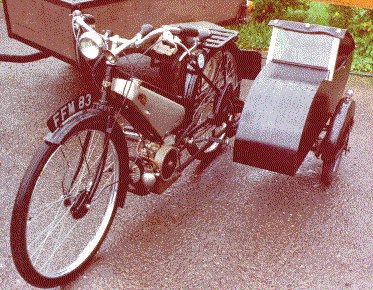 Go
to the Archive index
Go
to the Archive indexThe name Coventry-Eagle has appeared on pedal cycles from Victorian times right up to the present day. As the name implies, the company was formed in Coventry. During the 1920s, Coventry-Eagle began manufacturing a range of motor cycles; from big V-twins to little lightweights with pressed steel frames. The first Coventry-Eagle autocycle was produced towards the end of 1938 and was designated the model name Q12 Auto-Ette. (Coventry-Eagle model numbers have a prefix to indicate their year of manufacture; Q for the 1939 season, R for 1940, and so on.) The Auto-Ette followed the standard layout for a Villiers Junior powered machine. The fuel tank was a large one, filling the frame; most of its contemporaries had small tanks and did not adopt this feature until later. It was not sprung and did not have engine covers. The model continued in production for 1940 (renumbered, of course, to R12); the engine fitted was the improved Junior De Luxe.

A Coventry-Eagle R12 Auto-Ette
fitted with a Watsonian sidecar
In March 1940 it was joined by second model: the R14 Fly-Ette. This had engine covers that curved outwards at the front, protecting the rider's feet from any spray thrown up by the front wheel. The R14 was also unsprung. Production of these autocycles (along with the rest of the motor cycle range) was halted by World War II and, although pedal cycle production continued, no Coventry-Eagle motor cycles were produced after the war.
The next article in this series will describe the Cyc-Auto.
First published at www.autocycle.freeserve.co.uk in July 1998
A more recent and more comprehensive article on the Coventry-Eagle autocycle is Last Flight of the Eagle on the Iceni CAM Website